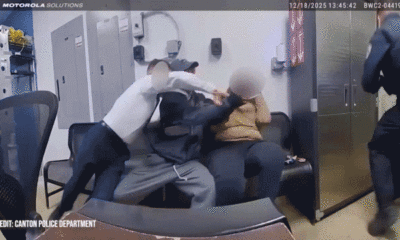Fitness
Ohio State exercise experts explore how New Year’s fitness resolutions affect campus gym attendance

Ohio State exercise experts weigh in on how students’ New Year’s fitness resolutions affect campus gym attendance. Credit: Lantern File Photo
On Dec. 6, 2023, the last day of regularly scheduled classes for the autumn semester, the total number of BuckID swipes used to enter gym facilities across campus was 8,245.
Roughly one month later on Jan. 8, this semester’s first day of regularly scheduled classes, that number rose to 13,463.
As Ohio State’s senior associate director of recreational sports Marci Shumaker said, this disparity represents an annual cycle in which campus gyms become increasingly packed at the beginning of the spring semester as many students are trying to fulfill and maintain their New Year’s fitness resolutions. Rick Petosa, Ohio State professor in health and exercise science, said this pattern, which sees gym attendance tend to decline as the year progresses, is observable in not only college students but adults in general.
Petosa said this trend can be best explained by the theory of reasoned action — a phenomenon whereby people have intentions to exercise rather than a plan to exercise.
“People love to set goals because the goals make them feel better,” Petosa said. “Very few people take it from that intention to actually developing a plan and then implementing the plan.”
Petosa said a concept called the Dunning-Kruger effect can also help explain why so many people are not successful in achieving their fitness goals. This effect states that the less experienced someone is with exercise, the more likely they are to underestimate the time and energy required to do so, set unrealistic fitness resolutions and inevitably fail, he said.
“Most of the things we do in our daily lives involve sitting and processing information,” Petosa said. “Exercise is getting up and actually using your body, which people call physical labor. So for a lot of people, it’s not part of their daily routine and there are substantial barriers to being physically active in a long-term sense.”
Throughout her 25 years at Ohio State, Shumaker, who oversees all programs, memberships, communications and data regarding Ohio State gym facilities, said she has observed the tendency for a high gym-going population throughout January and February, largely due to worsening weather conditions.
However, once March rolls around, she said there is a noticeable decrease in gym attendance.
“It’s partly because the weather gets better,” Shumaker said. “And I think people’s goals aren’t as far forward in their minds as maybe they are in January and February.”
To overcome these fitness barriers, Shumaker said Ohio State is working toward encouraging students to stay physically active year-round.
One way the university is doing so is through a new app called Ohio State Recreational Sports, which launched Jan. 8 and is powered by recreation mobile app FusionGo. The new app allows students to view facility operation hours, serves as another form of identification to enter the facilities and sends out important alerts concerning any relevant gym updates.
“I think it’s just creating as much access as possible, so that as many activities can be offered as possible this time of year when there’s the most demand,” Shumaker said.
Beyond the Ohio State Recreational Sports app, Shumaker said the university is employing various strategies — like introducing new fitness classes, upping housekeeping and encouraging participation in drop-in intramurals — to encourage students to maintain their gym-going even as winter melts away.
“Right now, all of the facilities are open, so you have lots to choose from,” Shumaker said. “They’re all gonna just be really busy these next few months, which is great. There’s lots of people who are new, and it’s exciting to see lots of people deciding to try different things.”
Regardless of how Ohio State students choose to get active, Petosa said he hopes they will keep an open mind and prioritize the process above all else.
“A lot of people when they set an intention, they focus on results like, ‘I’m going to look better, I’m going to get bigger, I’m going to be more fit,’ as opposed to the process, enjoying the exercise that they’re doing,” Petosa said. “If you’re gonna stick with something, enjoyment is very helpful. So, I always encourage people to pick a variety of activities and to pick activities that you enjoy doing.”

Fitness
Exercise ‘snacks’ can keep your fitness on track when time is tight – try these 3 today

December is great for many things – socialising, scoffing, falling out with relatives – but sticking to a training schedule is not one of them.
Heading out the door on Christmas morning for a two-hour long run is likely to put anyone on the naughty list, while it takes a dedicated runner indeed to spend part of the festive period running loops of the track.
What the mere mortal needs is exercise “snacks”. These can be enjoyed/endured alongside the carb-based variety and snuck in to even the busiest Christmas schedule.
A review in Sports Medicine and Health Research confirmed that regular, short bursts of physical activity throughout the day improved cardiovascular respiratory fitness, increased fat oxidation and polished off blood sugar levels after eating.
Vigorous intermittent exercises, such as sprints, were good for building muscle strength. Meanwhile, 10-minute resistance training sessions were found to be particularly beneficial to older people. The researchers concluded that exercise snacks could be a viable alternative to longer, less frequent sessions.
Cram in vigorous bouts of stair climbing for muscle strength, or one or two sub-10 minute morsels for muscle growth as an efficient alternative to meatier long sessions. Here’s some inspo below…
3 exercise snacks to gorge on
Try these simple workouts for results on the quick
For upper-body
Press-ups: 3 x 20 with a 30-sec rest between (b/w) reps
Bench dips: 3 x 15 with a 30-sec rest b/w reps
For lower-body
Bodyweight squats: 3 x 20 with 20-sec rest b/w reps
Wall sit: 2 x 90 secs with 1-min rest b/w reps
For cardio fitness
Burpees: 3 x 20 with 30-sec rest b/w reps
Skipping: 4mins consisting of 1min normal, 1min high knees, 1min normal, 1min high knees
Fitness
Study shows the antioxidants in this tea improve exercise recovery

I love many different herbal teas just as much as I enjoy a good old-fashioned British cup of PG tips, Earl Grey, or Glengettie — a Welsh favorite from the rolling valleys where I was born. In an interesting study, researchers explored whether drinking green or matcha tea can improve sports performance and exercise recovery, and the results might have you reaching for a vibrant green drink. If you want to get straight to the results, the short answer is that drinking green and matcha tea can support hydration, body fat control, and exercise recovery. Still, it definitely won’t be a game-changer when it comes to your performance in the gym, on the court, or on the field.
Hydrating with tea
In a study published in Nutrition and Food Technology, researchers reviewed existing studies of athletes and active adults that focused solely on drinking tea — no pills or extracts. They revealed that green or matcha tea can help hydrate the body when consumed in normal amounts. Tea counts toward your daily water intake.
Antioxidants and recovery

The research highlighted how the widely-studied antioxidants in green and matcha tea can improve exercise recovery and help protect your cells from the stress associated with intense exercise. That said, the research shows that drinking tea won’t lead to faster or better strength gains, so it’s no silver bullet for helping you achieve your fitness goals. However, they also concluded that low-caffeine green tea could even improve sleep quality, which I would argue could potentially help you power through that workout if you’re getting better sleep the night before.
Linked to lower body fat

Interestingly, the study authors also concluded that drinking around two or three cups of green or matcha tea per day was associated with slightly lower body fat and improved body composition and fat burning. While the effects weren’t overly significant, they were noted in the research. Cup of tea, anyone?
Fitness
Taylor Swift’s fitness strategy that made 632 days long Eras Tour possible: Her exercise routine to stay energized

Preparing for a Physical Marathon
Before the tour began, Swift recognized the physical challenge she was about to face. “I never would’ve believed you if you told me we were doing a three-and-a-half-hour show. Saying it is one thing, doing it is another,” she admitted in the Disney+ docuseries The End of an Era. For comparison, her longest previous show had lasted just two hours and 15 minutes.
To meet these demands, Swift began training six months ahead of her first rehearsal. Her daily treadmill sessions mirrored the tempo of the songs she would perform live, with faster tracks prompting running and slower songs calling for brisk walks or light jogging. “You just don’t want them to see you panting,” she explained to TIME.
Strength and Conditioning Regimen
While cardio built endurance, strength training ensured she could perform high-energy choreography without fatigue. Under the guidance of longtime trainer Kirk Myers, Swift tackled exercises such as battle ropes, medicine ball throws, assisted pull-ups, sledgehammer workouts, leg raises, and Russian twists. Myers described her as “the most resilient person I have ever met,” highlighting her ability to persevere through challenging workouts.
Swift’s humor surfaced even during difficult exercises. “In no way do I ever apply this … at any point in the show, I just want to flag that as I do every time I have to do pull-ups. Strong dislike. Two thumbs down,” she said, referring to resistance band-assisted pull-ups. She jokingly attributed her increasing strength to “all the pent-up rage and resentment” she felt toward the moves.
Dance Training and On-Stage Precision
Beyond the gym, Swift committed three months to dance rehearsals with choreographer Mandy Moore to ensure every move was second nature. “I wanted to be so over-rehearsed that I could be silly with the fans, and not lose my train of thought,” she shared with TIME. The precision extended to rapid costume changes, often completed in under 1 minute and 15 seconds, with the fastest taking just 39 seconds.
Swift ran an estimated eight miles per show while performing over 40 songs that spanned her musical eras. High-cardio sections, including the 1989 and Reputation sets, were particularly demanding. Yet she described the physical challenge as secondary to the personal purpose the tour provided, especially during a period marked by two breakups.
-

 Iowa1 week ago
Iowa1 week agoAddy Brown motivated to step up in Audi Crooks’ absence vs. UNI
-

 Maine1 week ago
Maine1 week agoElementary-aged student killed in school bus crash in southern Maine
-

 Maryland1 week ago
Maryland1 week agoFrigid temperatures to start the week in Maryland
-

 New Mexico7 days ago
New Mexico7 days agoFamily clarifies why they believe missing New Mexico man is dead
-

 South Dakota1 week ago
South Dakota1 week agoNature: Snow in South Dakota
-

 Detroit, MI1 week ago
Detroit, MI1 week ago‘Love being a pedo’: Metro Detroit doctor, attorney, therapist accused in web of child porn chats
-

 Health1 week ago
Health1 week ago‘Aggressive’ new flu variant sweeps globe as doctors warn of severe symptoms
-

 Maine7 days ago
Maine7 days agoFamily in Maine host food pantry for deer | Hand Off


















